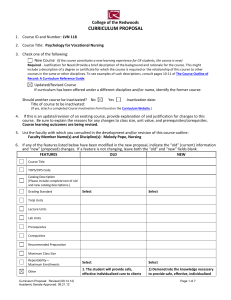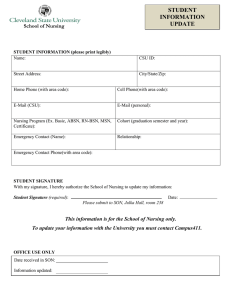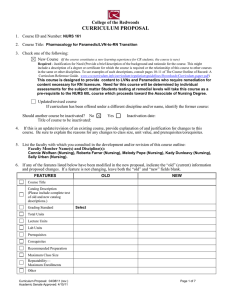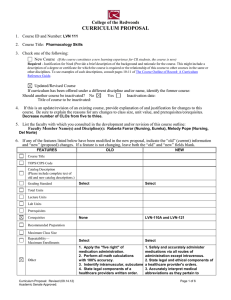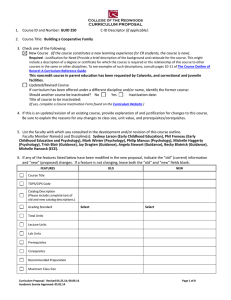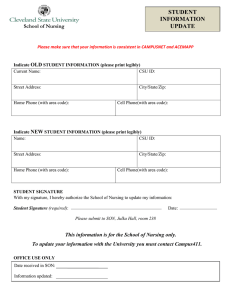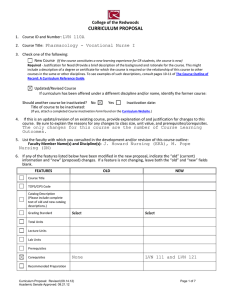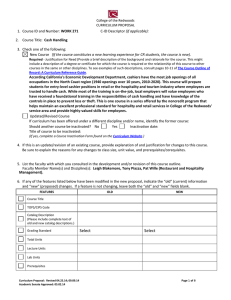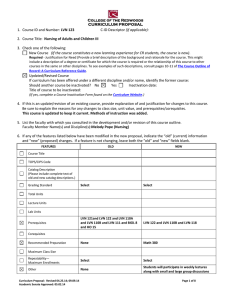LVN 121 (if applicable): Nursing of Adults and Children I
advertisement
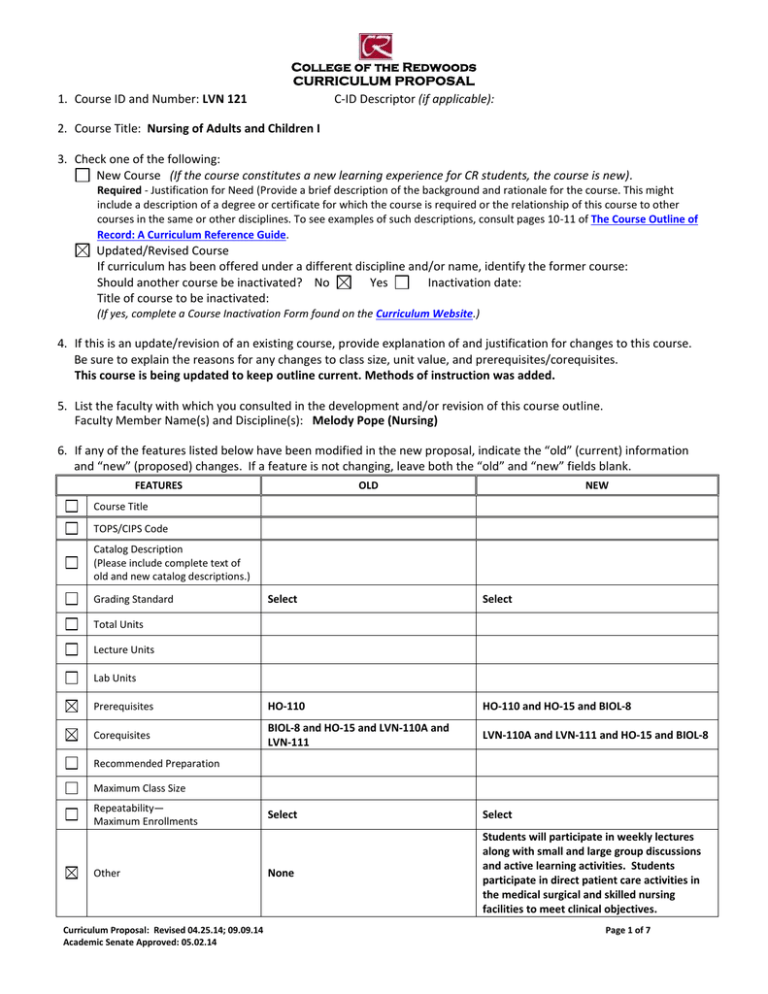
1. Course ID and Number: LVN 121 College of the Redwoods CURRICULUM PROPOSAL C-ID Descriptor (if applicable): 2. Course Title: Nursing of Adults and Children I 3. Check one of the following: New Course (If the course constitutes a new learning experience for CR students, the course is new). Required - Justification for Need (Provide a brief description of the background and rationale for the course. This might include a description of a degree or certificate for which the course is required or the relationship of this course to other courses in the same or other disciplines. To see examples of such descriptions, consult pages 10-11 of The Course Outline of Record: A Curriculum Reference Guide. Updated/Revised Course If curriculum has been offered under a different discipline and/or name, identify the former course: Should another course be inactivated? No Yes Inactivation date: Title of course to be inactivated: (If yes, complete a Course Inactivation Form found on the Curriculum Website.) 4. If this is an update/revision of an existing course, provide explanation of and justification for changes to this course. Be sure to explain the reasons for any changes to class size, unit value, and prerequisites/corequisites. This course is being updated to keep outline current. Methods of instruction was added. 5. List the faculty with which you consulted in the development and/or revision of this course outline. Faculty Member Name(s) and Discipline(s): Melody Pope (Nursing) 6. If any of the features listed below have been modified in the new proposal, indicate the “old” (current) information and “new” (proposed) changes. If a feature is not changing, leave both the “old” and “new” fields blank. FEATURES OLD NEW Course Title TOPS/CIPS Code Catalog Description (Please include complete text of old and new catalog descriptions.) Select Select Prerequisites HO-110 HO-110 and HO-15 and BIOL-8 Corequisites BIOL-8 and HO-15 and LVN-110A and LVN-111 LVN-110A and LVN-111 and HO-15 and BIOL-8 Select Select None Students will participate in weekly lectures along with small and large group discussions and active learning activities. Students participate in direct patient care activities in the medical surgical and skilled nursing facilities to meet clinical objectives. Grading Standard Total Units Lecture Units Lab Units Recommended Preparation Maximum Class Size Repeatability— Maximum Enrollments Other Curriculum Proposal: Revised 04.25.14; 09.09.14 Academic Senate Approved: 05.02.14 Page 1 of 7 1. DATE: March 7,2015 2. DIVISION: Health, Physical Education and Athletics 3. [CB04] COURSE CREDIT STATUS: D Credit-Degree Applicable 4. [CB01] COURSE ID AND NUMBER: LVN 121 5. [CB02] COURSE TITLE: Nursing of Adults and Children I (Course title appears in Catalog and schedule of classes.) 6. SHORT TITLE: Nurs of Adults & Children I (Short title appears on student transcripts and is limited to 30 characters, including spaces.) 7. [CB03] LOCAL ID (TOPs code): 1230.20 Taxonomy of Program Codes 8. NATIONAL ID (CIP code): 51.3901 Classification of Instructional Program Codes 9. DISCIPLINE(S): Nursing Select from Minimum Qualifications for Faculty Course may fit more than one discipline; identify all that apply: 10. FIRST TERM NEW OR REVISED COURSE MAY BE OFFERED: Fall 2015 11. COURSE UNITS (Note: 1 lecture unit requires 18 hours in-class/36 hours out-of-class; 1 lab unit requires 54 in-class hours) [CB07] TOTAL UNITS: [CB06] 6.5 6.5 min. units max. units TOTAL HOURS: 243 243 min. hours max. hours Lecture Units: 3 Lab Units: 3.5 Lecture Hours: 54 Lab Hours: 189 11. MAXIMUM CLASS SIZE: 30 12. WILL THIS COURSE HAVE AN INSTRUCTIONAL MATERIALS FEE? No Yes Fee: $ If yes, attach a completed Instructional Materials Fee Request Form found on the Curriculum Website. GRADING STANDARD Letter Grade Only Pass/No Pass Only [CB12] Is this course a repeatable lab course? No Grade-Pass/No Pass Option Yes Is this course to be offered as part of the Honors Program? No If yes, how many total enrollments? Select Yes If yes, explain how honors sections of the course are different from standard sections. CATALOG DESCRIPTION - The catalog description should clearly describe for students the scope of the course, its level, and what kinds of student goals the course is designed to fulfill. The catalog description should begin with a sentence fragment. The first of three courses for Vocational Nursing students in the care of adults and children. The role and legal / ethical responsibilities of the vocational nurse and principles of health, illness and disease are covered. Nursing care of the elderly and the terminally ill are presented. Common body system disorders are discussed. Application of skills and concepts takes place in the clinical setting and in Simulation Lab. Special Notes or Advisories (e.g. Field Trips Required, Prior Admission to Special Program Required, etc.): Admission to the LVN Program is required. PREREQUISITE COURSE(S) No Yes Rationale for Prerequisite: Course(s): HO 110 and HO-15 and BIOL-8 Describe representative skills without which the student would be highly unlikely to succeed. Curriculum Proposal: Revised 04.25.14; 09.09.14 Academic Senate Approved: 05.02.14 Page 2 of 7 Basic skills in patient care and maintenance of a safe and healthful environment. COREQUISITE COURSE(S) No Yes Course(s): LVN 110A and LVN 111 and HO 15 and BIOL 8 if not previously completed. Rationale for Corequisite: Nursing courses must be taken in sequence as courses build on prior knowledge. Program outcomes are based on completion of coursework in a timely and structured sequence. RECOMMENDED PREPARATION No Yes Course(s): Math 380 Rationale for Recommended Preparation: Students must be able to perform basic math calculations. COURSE LEARNING OUTCOMES –This section answers the question “what will students be able to do as a result of taking this course?” State some of the outcomes in terms of specific, measurable student actions (e.g. discuss, identify, describe, analyze, construct, compare, compose, display, report, select, etc.). For a more complete list of outcome verbs please see Public Folders>Curriculum>Help Folder>SLO Language Chart. Each outcome should be numbered. 1. Describe and discuss the role of the vocational nurse related to fundamental patient care including hygiene, comfort and safety, basic assessment, legal and ethical issues and communication. 2. Define the nursing process and its components. 3. Develop a plan of care for patients experiencing acute and chronic disruptions in health status. 4. Discuss the rationale for the utilization of medications and fluid therapy. COURSE OBJECTIVES - This section describes the objectives the course addresses through the course content. Objectives can include specific disciplinary questions or goals that are central to the course subject matter and are meant to address what the various intents of the course are. Each objective should be numbered. 1. Nursing fundamentals. 2. Professional relationships and trends in health care. 3. Process of health and illness. 4. Concepts basic to the care of patients. 5. Plan and carry out the care of 1-2 patients. METHODS OF INSTRUCTION – Clear methods by which instructor will facilitate acquisition of objectives. Include here descriptions, NOT lists. Course outline must clearly articulate how these methods of instruction are related to, and help student work towards, achieving the objectives and student learning outcomes. Instructional methodologies will be consistent with, but will not be limited to, the following types orexamples. Students will participate in weekly lectures along with small and large group discussions and active learning activities. Students participate in direct pateint care activities in the medical surgical and skilled nursing facilities to meet clinical objectives. COURSE CONTENT–This section describes what the course is “about”-i.e. what it covers and what knowledge students will acquire. Concepts: What terms and ideas will students need to understand and be conversant with as they demonstrate course outcomes? Each concept should be numbered. 1. Health and illness. 2. Normal versus abnormal patient/client conditions across the lifespan. 3. Basic patient assessment and care. 4. Communication. 5. Health care team. 6. Structure and function of health care system. 7. Stress. 8. Patient care planning. 9. Uniqueness of the client, spiritual and cultural beliefs. 10. Institutional policies and procedures. 11. Evidence based practice. Issues: What primary tensions or problems inherent in the subject matter of the course will students engage? Each issue should be numbered. Curriculum Proposal: Revised 04.25.14; 09.09.14 Academic Senate Approved: 05.02.14 Page 3 of 7 1. Safe, effective, and efficient care. 2. Gender, age, race, and social status. Themes: What motifs, if any, are threaded throughout the course? Each theme should be numbered. 1. Patient safety. 2. Legal & ethical implications of nursing care. 3. Evaluation. 4. Patient education. Skills: What abilities must students have in order to demonstrate course outcomes? (E.g. write clearly, use a scientific calculator, read college-level texts, create a field notebook, safely use power tools, etc). Each skill should be numbered. 1. Provide basic nursing care for 1-2 patients. 2. Communicate appropriately and effectively both verbally and in writing. 3. Perform basic physical assessment, including vital signs. 4. Provide appropriate nursing care based upon developmental stage and spiritual and cultural beliefs of client. 5. Identify subjective and objective data as related to various stages of health and illness. 6. Plan and provide care to clients experiencing disruptions in physiologic functions. 7. Assess and provide care to clients experiencing pain. 8. Demonstrate ability to assist the registered nurse in establishing and monitoring various types of intravenous solutions and equipment. 9. Demonstrate the LVN role in “teaching” of clients and family members by using the “teaching process approach”. REPRESENTATIVE LEARNING ACTIVITIES –This section provides examples of things students may do to engage the course content (e.g., listening to lectures, participating in discussions and/or group activities, attending a field trip). These activities should relate directly to the Course Learning Outcomes. Each activity should be numbered. 1. Weekly lectures. 2. Small and large group discussions. 3. Critical thinking assignments. 4. Participate in direct patient care activities in the clinical setting. 5. Active learning activities. ASSESSMENT TASKS –This section describes assessments instructors may use to allow students opportunities to provide evidence of achieving the Course Learning Outcomes. Each assessment should be numbered. Representative Assessment Tasks (These are examples of assessments instructors could use.): 1. Participating in group discussions. 3. Responding to various patient care scenarios. 4. Role-playing learning activities. 5. Applying theoretical concepts in the clinical setting and in Simulation Lab. Required Assessments for All Sections (These are assessments that are required of all instructors of all sections at all campuses/sites. Not all courses will have required assessments. Do not list here assessments that are listed as representative assessments above.): 1. 2. 3. 4. 5. Quizzes. Midterm examination. Final examination. Critical thinking assignments. ATI practice and proctored assessment. EXAMPLES OF APPROPRIATE TEXTS OR OTHER READINGS –This section lists example texts, not required texts. Author, Title, and Date Fields are required Author Williams, Hopper Title Understanding Medical-Surgical Nursing 5th Edition Date 2015 Author ATI Title PN Medical/Surgical Nursing 5.0 Date 2010 Author Title Date Author Title Date Other Appropriate Readings: Curriculum Proposal: Revised 04.25.14; 09.09.14 Academic Senate Approved: 05.02.14 Page 4 of 7 COURSE TYPES 1. Is the course part of a Chancellor’s Office approved CR Associate Degree? No Yes If yes, specify all program codes that apply. (Codes can be found in Outlook/Public Folders/All Public Folders/ Curriculum/Degree and Certificate Programs/choose appropriate catalog year): Required course for degree(s) NURS.AS.LVN Restricted elective for degree (s) Restricted electives are courses specifically listed (i.e. by name and number) as optional courses from which students may choose to complete a specific number of units required for an approved degree. 2. Is the course part of a Chancellor’s Office approved CR Certificate of Achievement? No Yes If yes, specify all program codes that apply. (Codes can be found in Outlook/Public Folders/All Public Folders/ Curriculum/Degree and Certificate Programs/choose appropriate catalog year): Required course for certificate(s) NURS.CA.LVN Restricted elective for certificate(s) Restricted electives are courses specifically listed (i.e. by name and number) as optional courses from which students may choose to complete a specific number of units required for an approved certificate. 3. [CB24] Is the course Stand Alone? No Yes (If “No” is checked for BOTH #1 & #2 above, the course is stand alone.) 4. [CB08] Basic Skills: NBS Not Basic Skills 5. [CB10] Work Experience: NWE Not Coop Work Experience 6. [CB22] Noncredit Category: Credit course, not applicable 7. Course eligible Career Technical Education funding (applies to vocational and tech-prep courses only): No 8. [CB23] Course developed using a Chancellor’s Office Economic Development Grant: No Yes Yes 9. [CB11] Purpose: Y Credit Course Course Classification Status 10. Accounting Method: W Weekly Census 11. [CB13] Disability Status: N Not a Special Class 12. [CB09] Course SAM Priority Code: C Clearly Occupational Definitions of SAM Priority Codes COURSE TRANSFERABILITY 1. [CB05] Current Transferability Status: C Not Transferable 2. [CB21] Course Prior to Transfer Level: Y Not Applicable Definitions of Course Prior to Transfer Levels CURRENT TRANSFERABILITY STATUS (Check at least one box below): This course is currently transferable to: Neither CSU nor UC CSU as general elective credit CSU as a specific course equivalent (see below) If the course transfers as a specific course equivalent give course number(s)/ title(s) of one or more currently-active, equivalent lower division courses from CSU. 1. Course , Campus 2. Course , Campus UC as general elective credit UC as specific course equivalent If the course transfers as a specific course equivalent give course number(s)/ title(s) of one or more currently-active, equivalent lower division courses from UC. Curriculum Proposal: Revised 04.25.14; 09.09.14 Academic Senate Approved: 05.02.14 Page 5 of 7 1. Course , Campus 2. Course , Campus PROPOSED CSU TRANSFERABILITY (Check at least one of the boxes below): No Proposal Remove as General Education Propose as General Elective Credit Propose as a Specific Course Equivalent (see below) If specific course equivalent credit is proposed, give course number(s)/ title(s) of one or more currently-active, equivalent lower division courses from CSU. 1. Course , Campus 2. Course , Campus PROPOSED UC TRANSFERABILITY (Check one of the boxes below): No Proposal Remove as General Education Propose as General Elective Credit OR Specific Course Equivalent (fill in information below) If “General Elective Credit OR Specific Course Equivalent” box above is checked, give course number(s)/ title(s) of one or more currently-active, equivalent lower division courses from UC. 1. Course , Campus 2. Course , Campus CURRENTLY APPROVED GENERAL EDUCATION (Check at least one box below): Not currently approved CR CR GE Category(-ies): Select GE Category, Secondary GE Category (if applicable) CSU CSU GE Category: IGETC IGETC Category: PROPOSED CR GENERAL EDUCATION (Check at least one box below): No Proposal Remove as General Education Review to maintain CR GE Status New GE Proposal ____ _Approved as CR GE by Curriculum Committee: _______ _ ____ _ Not Approved (DATE) ____ _ Approved to remove CR GE status CR GE Outcomes GE learning outcomes in Effective Communication, Critical Thinking, and Global Awareness must be addressed in all general education courses. o Effective Communications: Explain how the proposed GE course fulfills at least one of the CR GE outcomes in this category. o Critical Thinking: Explain how the proposed GE course fulfills at least one of the CR GE outcomes in this category. o Global Awareness: Explain how the proposed GE course fulfills at least one of the CR GE outcomes in this category. GE Criteria for Breadth and Generality GE courses should be broad and general in scope. Typically such courses are introductory-- not advanced or specialized—and the content encompasses a broad spectrum of knowledge within a given field of study. Explain how the proposed GE course fulfills GE criteria for breadth and generality. CR GE Area Designation Course Learning Outcomes and Course Content should provide evidence of appropriate GE Area Designation. Additional rationale for GE Area Designation (optional): Area A: Area B: Area C: Area D: Natural Science Social Science Humanities Language and Rationality D1: Writing Curriculum Proposal: Revised 04.25.14; 09.09.14 Academic Senate Approved: 05.02.14 Page 6 of 7 D2: Oral Communications D3: Analytical Thinking Area E: Multicultural Understanding* *To be considered part of CR GE Area E, all courses must meet the following two conditions: 1. The course must also be (or be proposed) in one other CR GE area AND 2. The course must be articulated with HSU as meeting their lower-division Diversity and Common Ground GE requirement. PROPOSED CSU GENERAL EDUCATION BREADTH (CSU GE) (Check at least one box below): NO PROPOSAL A. Communications and Critical Thinking A1 – Oral Communication A2 – Written Communication A3 – Critical Thinking B. Science and Math B1 – Physical Science B2 – Life Science B3 – Laboratory Activity B4 – Mathematics/Quantitative Reasoning C. Arts, Literature, Philosophy, and Foreign Language C1 – Arts (Art, Dance, Music, Theater) C2 – Humanities (Literature, Philosophy, Foreign Language) D. Social, Political, and Economic Institutions D0 – Sociology and Criminology D1 – Anthropology and Archeology D2 – Economics D3 – Ethnic Studies D5 – Geography D6 – History E. Lifelong Understanding and Self-Development D7 – Interdisciplinary Social or Behavioral Science E1 – Lifelong Understanding D8 – Political Science, Government and Legal Institutions E2 – Self-Development D9 – Psychology Rationale for inclusion in this General Education category: Same as above Proposed Intersegmental General Education Transfer Curriculum (IGETC) (Check at least one box below): NO PROPOSAL 1A – English Composition 1B – Critical Thinking-English Composition 1C – Oral Communication (CSU requirement only) 2A – Math 3A – Arts 3B – Humanities 4A – Anthropology and Archaeology 4B – Economics 4E – Geography 4F – History 4G – Interdisciplinary, Social & Behavioral Sciences 4H – Political Science, Government & Legal Institutions 4I – Psychology 4J – Sociology & Criminology 5A – Physical Science 5B – Biological Science 6A – Languages Other Than English Rationale for inclusion in this General Education category: Same as Above Submitted By: Jessica Howard Tel. Ext.: 4248 Dean/Director: Joe Hash Date: March 6, 2015 Review Date: 3/20/2015 For Dean/Director only: Does this course change require a substantial or nonsubstantial change to a degree? Yes CURRICULUM COMMITTEE USE ONLY Approved by Curriculum Committee: No Yes Date: 03.27.15 Academic Senate Approval Date: Board of Trustees Approval Date: Curriculum Committee Approved: 04.25.14; 09.01.14 Academic Senate Approved: 05.02.14 Page 7 of 7 No
